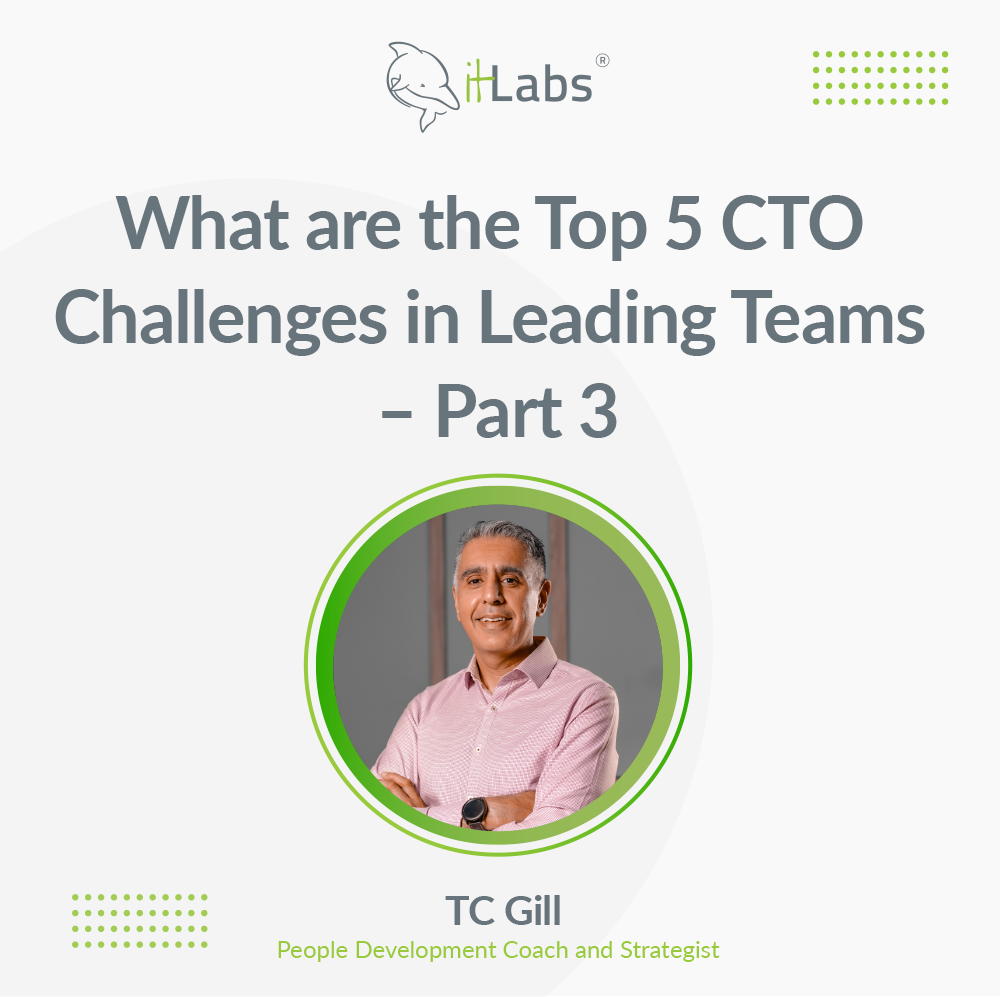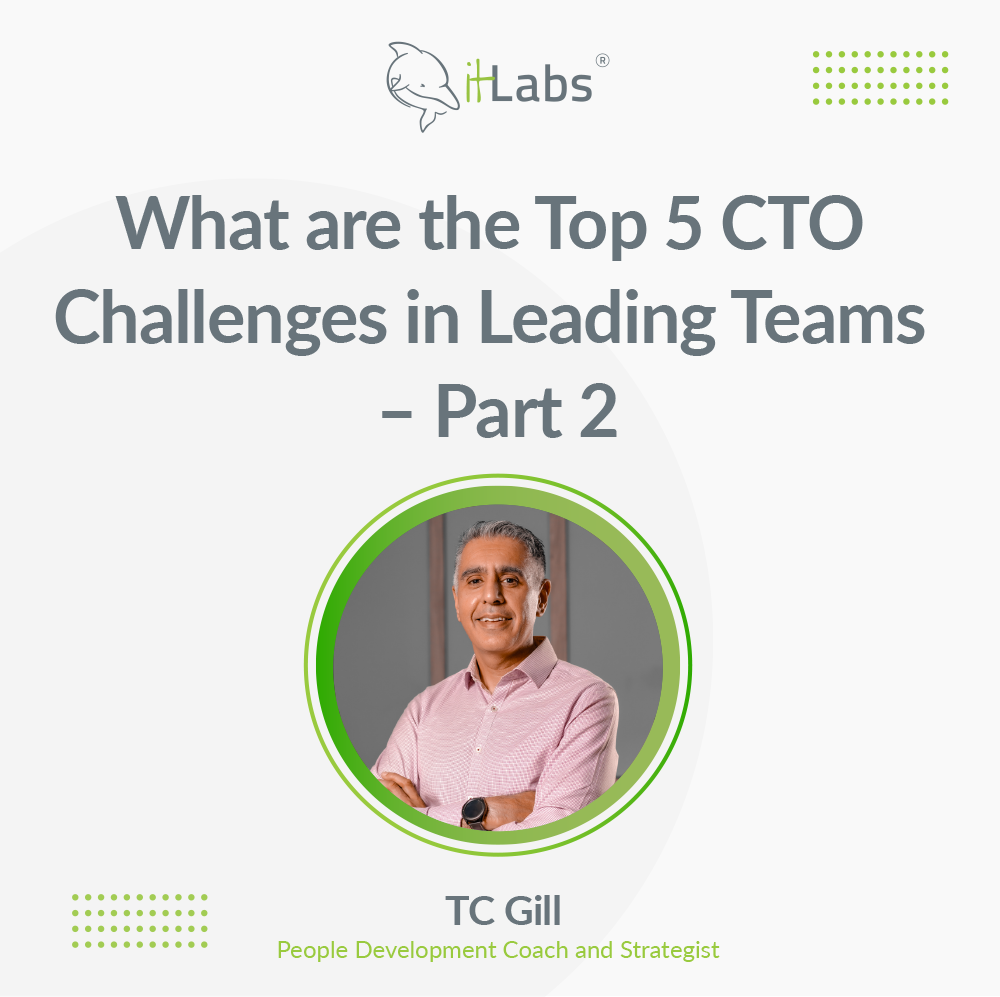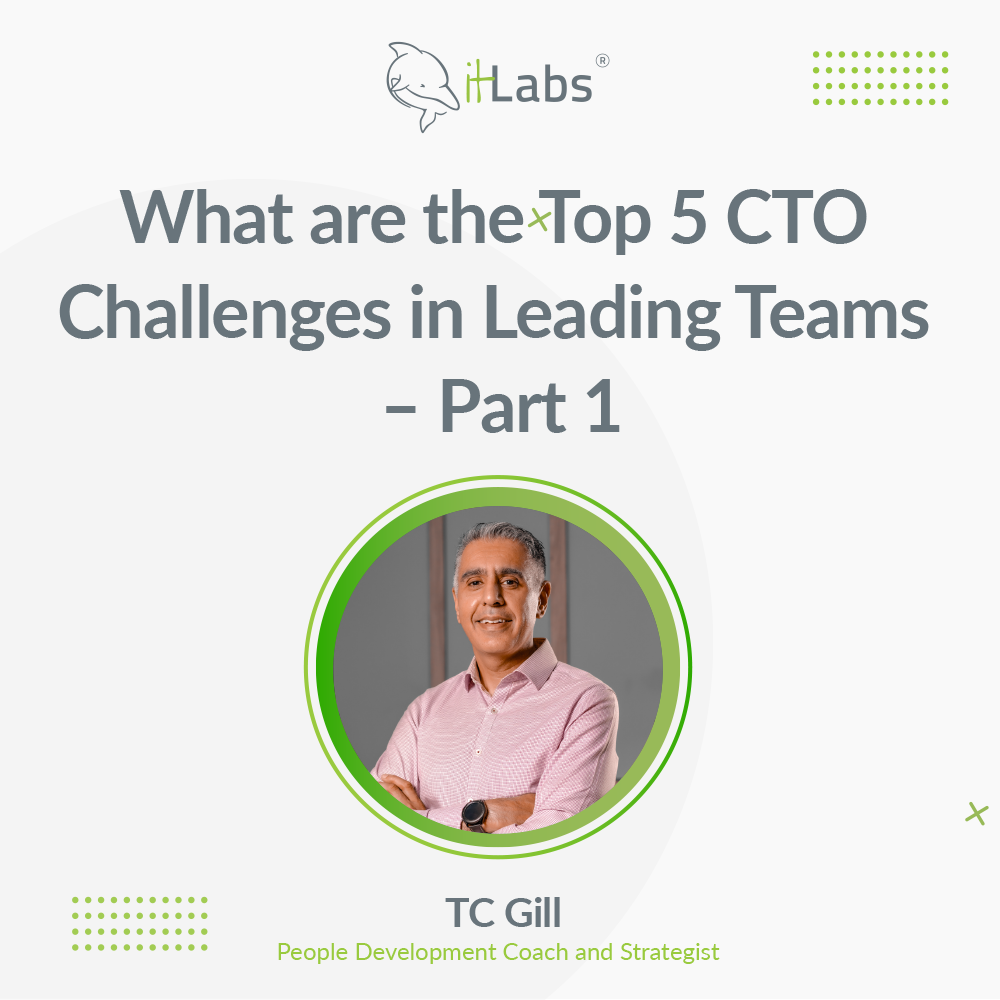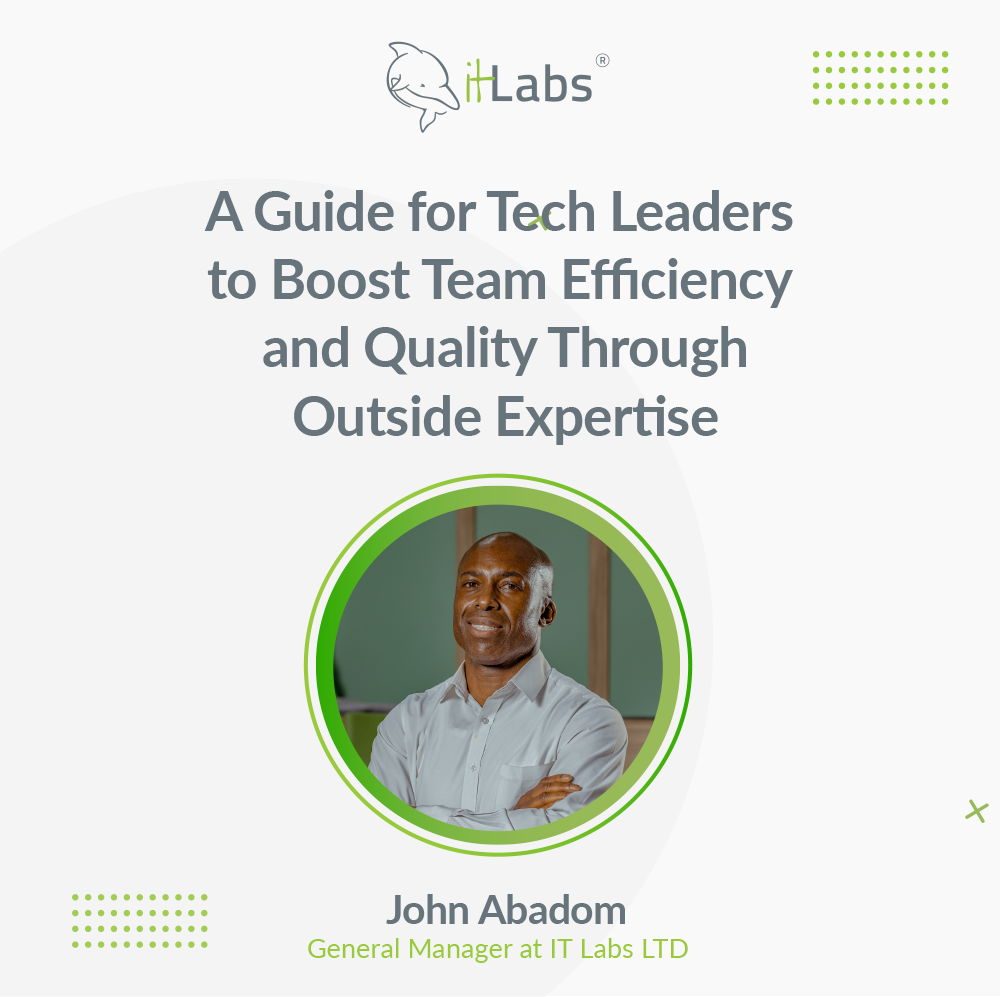What are the Top 5 CTO Challenges in Leading Teams – Part 3
What are the Top 5 CTO Challenges in Leading Teams – Part 3
By TC Gill

What was once a playground for innovation and experimentation has now transformed into a strategic battleground where every technological endeavor must align with broader business objectives. This shift marks a departure from the era of tech for tech’s sake to one where every innovation must serve a purpose – to meet the needs of the customer and drive organizational success. As we delve deeper into the following challenge, it becomes evident that several key aspects contribute to its complexity.
The challenge of creating team alignment to business goals
Gone are the days when tech was such a cool thing, we knocked out tech for tech’s sake. It was a bit of a crazy fun party where everywhere you turned; people were creating tech for dubious “good” reasons. Well party time is over. The innovation storm that the tech world resides in just doesn’t have room for doing things because we think they seem kind of funky. We must buckle up and align to the outcomes the business needs, which is strongly underlined by the outcomes the end customer wants!
Here are some of the aspects that need to be considered in order to understand this challenge:

Changing Landscape
Gone are the days when technological prowess alone could guarantee success in the marketplace. Today, tech leaders find themselves grappling with the daunting task of navigating a rapidly changing landscape where the focus has shifted towards delivering tangible business outcomes. The challenge lies in steering the ship away from the allure of technological novelty towards a course that is firmly aligned with the overarching goals of the organization.
Communication Gap
One of the foremost challenges in aligning tech teams with business goals lies in bridging the communication gap that often exists between technical experts and the broader objectives of the company. Without clear and consistent communication channels, team members may find themselves adrift in a sea of technical jargon, disconnected from the larger vision of the organization. It is imperative for tech leaders to establish transparent communication channels that ensure every team member understands how their work contributes to the company’s success.
Vision Alignment
Another critical aspect of the challenge is ensuring that every member of the tech team is aligned with the company’s vision. Without a shared sense of purpose, individual efforts may diverge, leading to fragmentation and inefficiency. Tech leaders must take proactive steps to articulate and reinforce the company’s vision, integrating it into every aspect of the team’s operations. By fostering a shared understanding of the organization’s goals and values, tech leaders can create a cohesive team that is united in its pursuit of success.
Measurement and Evaluation
Finally, aligning tech teams with business goals requires a shift in focus from output metrics to outcome-oriented measurements. Too often, teams are judged solely on their ability to deliver projects on time and within budget, without considering the broader impact of their work. Tech leaders must redefine success metrics to emphasize the value their teams bring to the organization, focusing on outcomes such as customer satisfaction, revenue growth, and market share. By aligning performance metrics with business objectives, tech leaders can ensure that every member of the team is working towards a common goal.
How to create that alignment in your teams
So let me share with you what I think are the strategies for tech leaders to align teams with business goals. Here are a few that I’ve seen employed by tech leaders in my community.
Clarity in communication
Firstly, let’s get great at that thing that flows in all human systems, communication. Create crystal-clear communications on our collective objectives. As a CTO, it’s imperative to ensure that your team is not just aware of, but fully understands the broader business objectives. This means consistently communicating the goals, strategies, and expectations in a clear and concise manner. It’s about making sure everyone is on the same page and moving in the same direction.
Know where you want to go
As the leader in the space, it’s your top priority to reinforce a unified vision. I suggest continuously articulate and reinforce the company’s vision, over and over again. Integrate the vision into every conversation and decision-making process. The goal is to embed this vision deeply into the team’s mindset, so much so that it becomes a natural part of their thought process and approach to work.

Feedback, feedback, feedback
Businesses are a system of systems, and all healthy systems have healthy feedback loops. So, provide ongoing updates and feedback. Keep the team in the loop with regular updates on progress, changes, and any shifts in strategy. This ongoing communication is key to maintaining alignment, as it helps the team understand how their work fits into the larger picture and adapt as needed.
Outcomes are important as well!
Also focus on outcomes, not just outputs. Shift the emphasis from mere output or quantity of work to the impact of that work on business and customer outcomes. Make it clear that success is measured not just by what is produced, but by how it contributes to the company’s goals and adds value to the customer experience.
By implementing these strategies, tech leaders can effectively overcome the challenge of aligning their teams with the business goals, ensuring that every member contributes meaningfully towards the collective success of the organization.
Takeaways
Clarity, communication, and a strong commitment to a common vision are essential for success.
Tech executives may create a course for relevance and resilience by embracing the changing tech landscape and anchoring every endeavour to strategic goals. Leaders build a unified front in which every team member participates meaningfully by communicating openly and relentlessly on the company’s vision.
Furthermore, by redefining success measurements, leaders foster an environment of accountability and creativity in which every accomplishment moves the organisation ahead.
Let us carry on the lessons we’ve learned: true magic is found in transforming businesses, inspiring teams, and improving customer lives. With vision as our compass and collaboration as our guide, let us forge ahead into the unknown, seeing problems as possibilities and crafting a future where innovation knows no bounds.

Author
TC Gill – People Development Coach and Strategist
What are the Top 5 CTO Challenges in Leading Teams – Part 2
What are the Top 5 CTO Challenges in Leading Teams – Part 2
By TC Gill

In the whirlwind world of technology, where innovation and change are the only constants, the role of a CTO transcends mere management. It’s a dance on the razor’s edge of progress, where every step forward is met with new challenges.
At the heart of this dynamic arena is the challenge of leadership — how to guide, inspire, and retain a team of brilliant minds that are the lifeblood of technological advancement. The second part of this series delves into the nuanced world of tech leadership, dissecting the top challenges CTOs face in rallying their troops toward innovation and success.
Looking for Part 1? You can find it right here –> Part 1
Otherwise, dive in.
The challenge of recruiting and retaining top notch people
As we peel back the layers of tech leadership, we uncover a series of intricate challenges that CTOs face in the digital age. These hurdles are not just about technology; they’re about people, processes, and the delicate balance between innovation and stability. Each challenge presents a unique puzzle, requiring a blend of strategic foresight, empathy, and adaptability. In this section, we explore these pivotal issues, offering insights and strategies to navigate the complex terrain of leading tech teams to triumph.

Navigating the Talent War
The tech industry is notorious for its fierce competition for talent. CTOs are often at the forefront of this battle, striving to not just attract but also retain the brightest minds. This challenge is compounded by the rise of remote work, which has widened the talent pool but also intensified competition. Leaders must be adept at showcasing their company’s unique value proposition and crafting a work environment that caters to the diverse needs of today’s tech professionals.
Fostering Innovation While Maintaining Stability
Balancing the drive for innovation with the need for stable, reliable systems is a tightrope walk. CTOs must champion forward-thinking projects and technologies without jeopardizing the core operations that keep the business running smoothly. This requires a strategic mindset, capable of assessing risks and making informed decisions that align with long-term objectives.
Adapting to Rapid Technological Changes
The pace of technological advancement is unrelenting. CTOs must ensure their teams are not only up-to-date with the latest technologies but also proficient in them. This entails a commitment to continuous learning and development, fostering a culture where adaptation and growth are part of the daily routine.
Ensuring Team Cohesion in a Diverse Environment
Today’s tech teams are more diverse than ever, spanning different cultures, time zones, and working styles. While this diversity is a strength, it also presents a challenge in maintaining a cohesive team dynamic. Effective communication, inclusive leadership practices, and a strong sense of shared purpose are essential in unifying the team.
Leading Through Uncertainty
The tech industry is no stranger to uncertainty, be it from market fluctuations, regulatory changes, or emerging competitors. CTOs must lead with confidence and clarity, even when the path ahead is murky. This involves making tough decisions with incomplete information, managing stakeholder expectations, and keeping the team focused and motivated despite external pressures.
The Road to Finding and Retaining Top Talent
So, drawing from my personal lived stories and insights gained from dialogues with fellow tech leaders, lets answer the question of how can we effectively attract and retain top talent?


Enticing Talent with Compelling Rewards
Starting with the obvious, offer competitive compensation and attractive benefits to boot. All leaders want value from their talent and to get that, we have to offer reasonable value in return. i.e. a package that’s not just fair, but also appealing in the competitive tech landscape. You’ve often got to stand out. So, I encourage you to get creative on how you can do that. This doesn’t just include attractive salaries. Throw in a spectrum of comprehensive benefits, and additional perks.
Cultivating an Irresistible Workplace Vibe
Get incredibly intentional about cultivating the right culture. Building a culture that naturally draws in talent is crucial. This means creating an environment that’s inclusive, innovative, and aligns with the values and aspirations of the professionals you want to attract. A really delightful book on this that I’ve read, as well as many of the tech leaders I spoke to is “No Rule Rules” by Reed Hastings & Erin Meyer (the Netflix culture). Never leave culture to chance. Be intentional in its design and maintenance.
Empowering Teams Through Growth Initiatives
See everyone in your team as a unique person in their own right through commitment to their professional growth. Investing in the continuous development of your team not only enhances their skills but also shows your commitment to their career progression. This can be through ongoing training, mentorship programs, and opportunities for advancement. When people feel like they are growing, they feel fulfilled and that not only makes the feel like they belong, but it also creates a gravity that attracts others to want to be part of your team space.
Harmonizing Work and Well-being
Find the right balance of work with sustainable working practices. I really encourage leaders to embrace the principle of sustainable working as outlined in the Agile methodology. This involves creating a work environment that promotes balance, efficiency, and respect for individual needs and boundaries. Also listen and observe when the balance is out. Use this feedback loop as often as possible to tune the efforts of the team to not only serve the value delivered to the customer, but the wellbeing of your people.
Inspiring Passion and Commitment
Don’t just see the work as work. i.e. Something to be ticked off. Great leaders create engagement through making the work purposeful. Ensure you teams understand how their roles contribute to the broader business objectives and the impact on the end customer. i.e. How their work is journeying towards a vision that will make a difference. In addition, encourage creativity and innovation in their approach. When employees feel their work is purposeful and they are part of the bigger picture, their engagement and loyalty to the company increases significantly.
By focusing on these areas, tech leaders can create a magnetic pull for top talent and foster a culture where they choose to stay and thrive.

Author
TC Gill – People Development Coach and Strategist
What are the Top 5 CTO Challenges in Leading Teams – Part 1
What are the Top 5 CTO Challenges in Leading Teams – Part 1
By TC Gill

Questions around leading and management of teams have been on my (and other tech leaders I assume) – specifically, what are the most common challenges? Someone asked me this question, and while I should’ve had it all wrapped up in my head, it kind of stopped me in my tracks. Not because I was stuck for answers, but because there are so many that came to mind. Being the “Chief talking Officer” (CtO) of the CTO Confessions podcast and leading many technical people into the space of leadership – I was properly spoilt for choice.
So, I decided to “go long” with this – with the goal to cover the most important aspects of what the challenges are, and what tech leaders can do to overcome them, covered in 5 parts.
We’re kicking off with a problem that is fairly recent.
The Challenge of Orchestrating Remote Teams
This is any leader’s labyrinth now – not just tech leaders. Unless you’ve been hiding under some very big rocks, a new era unfolded in the world. Many companies were using remote working to some extent, especially in the tech space, but COVID did a number on us. This wasn’t just a change; it was a quantum leap into a new reality for many business functions. Remote became a norm that we had to adapt to quickly.
Looking at the concept of remote work, it comes with a variety of benefits and drawbacks – with the drawbacks’ list now seemingly growing, with research now pointing in a different direction, as well as statements and claims of influential tech leaders. So I’ll focus on the challenges posed by remote and diverse teams, and the biggest problems relating to it.


We lost the art of mingling
This is a big one for me. Remember the good old days when we had watercooler moments and team lunches with actual real people in front of us? Sadly, this seems a thing of the past. Or at least for it to happen regularly. Trying to foster and invigorate the social system and serendipitous moments of people meeting has turned into a challenging high wire act… without a safety net.
UTC, ET, or CST?
Second one added to the challenge cocktail – leaders must be global multi time zone orchestrators. It’s a global thing now. The world got a lot smaller and bigger at the same time, with mornings, afternoons and evenings sometimes all in a meeting at once. This difference in time-zones can be a strain on operations in any team, and can lead to lapses in communication, and lower collaboration.
Trust & Communication
The lack of contact and face-to-face time can be a hurdle in establishing a culture, principles, and some simple common understanding in teams. Add the global-ness into the mix, with the diversity of cultures that all have their own norms – and you’re walking a delicate line in terms of leading. And this is where this whole thing can crumble like a tower of cards – lack of connection gives way to lack of trust, then bad communication, lack of collaboration…well, I won’t keep on catastrophizing – you get the picture.
Now let’s jump to what we can do!

How to walk the leadership walk
So, how do we perform this high wire act of orchestrating remote and diverse teams? What steps can we take to enhance your approach? Drawing down from my personal experience and insights gathered from interviews and meetings with more than 100 tech leaders, I’ve come up with the following list:
- Prioritize the social fabric of your workplace. It’s crucial to put a spotlight on the social dynamics within the team. What I like to call “the social system”. Nurturing relationships and understanding interpersonal dynamics are key to not just productivity, but also satisfaction.
- And on top of that make it real! facilitate real-life connections. Whenever possible, arrange for the team to meet in person. An initial face-to-face gathering, especially an icebreaker event, can lay a strong foundation for future remote interactions. If you can’t do this, I implore you to get creative on how you can do this remotely. Whatever happens, people must get to know each other. As my personal leadership mantra goes: “Relationship first”.
- The third thing on my list is equip your people with the right tools for effective collaboration. The digital toolbox is essential for seamless remote work and maintaining productivity. But again, don’t just throw the tools into the space, think about how they can be used elegantly. Tap into the teams with continuous learning about the way they work, and how this learning can be brought to life to create an iteratively smoother ride for all concerned.
- And finally in the context of remote working, develop skills and processes that make it easy, productive, and fun. It’s not just about being able to see each other on a screen. Cultivating the right skills and establishing robust processes for remote work are critical for success. Don’t leave it to chance. Lead the way. Get people thinking about what’s working well and what’s not. I suggest conducting cyclic remote working retrospectives for learning and adaptation.
Thankfully, many of the tech leaders I’ve worked with and met, work on the said topics in a big way. I hope some of the ideas here inspire you to put a bright spotlight on the topic.
Stay tuned for Part 2, coming next week!

Author
TC Gill – People Development Coach and Strategist
A Guide for Tech Leaders to Boost Team Efficiency and Quality Through Outside Expertise
Articles

John Abadom
General Manager at IT Labs LTD
In the ever-evolving landscape of technology, businesses often find themselves grappling with the challenge of developing innovative software solutions to stay ahead of the competition – and with the advancements made in technology, coupled with the customer and market demands, innovation has turned from goal to a necessity.
For businesses and leaders that lack the capacity to create and deploy software, the journey from conception to execution can be a daunting one. This poses a problem that can be both resource and time-consuming – and one that can be easily solved by finding an external partner that can do this for them – like IT Labs.
Choosing your software development partner is not like choosing a regular vendor for your needs – it’s a strategic move that can empower your business by building resilient, scalable, and innovative applications. By leveraging you partner’s expertise and experience, you’re not just keeping up with the competition in the present – you’re laying the groundwork for a more sustainable future.
What Your Outside Expert Needs to Look Like
Considering the role, the implications, and the potential influence your software development partner might have on business growth, it’s important that you pick the right one. This means that your outside experts need to have the following qualities:
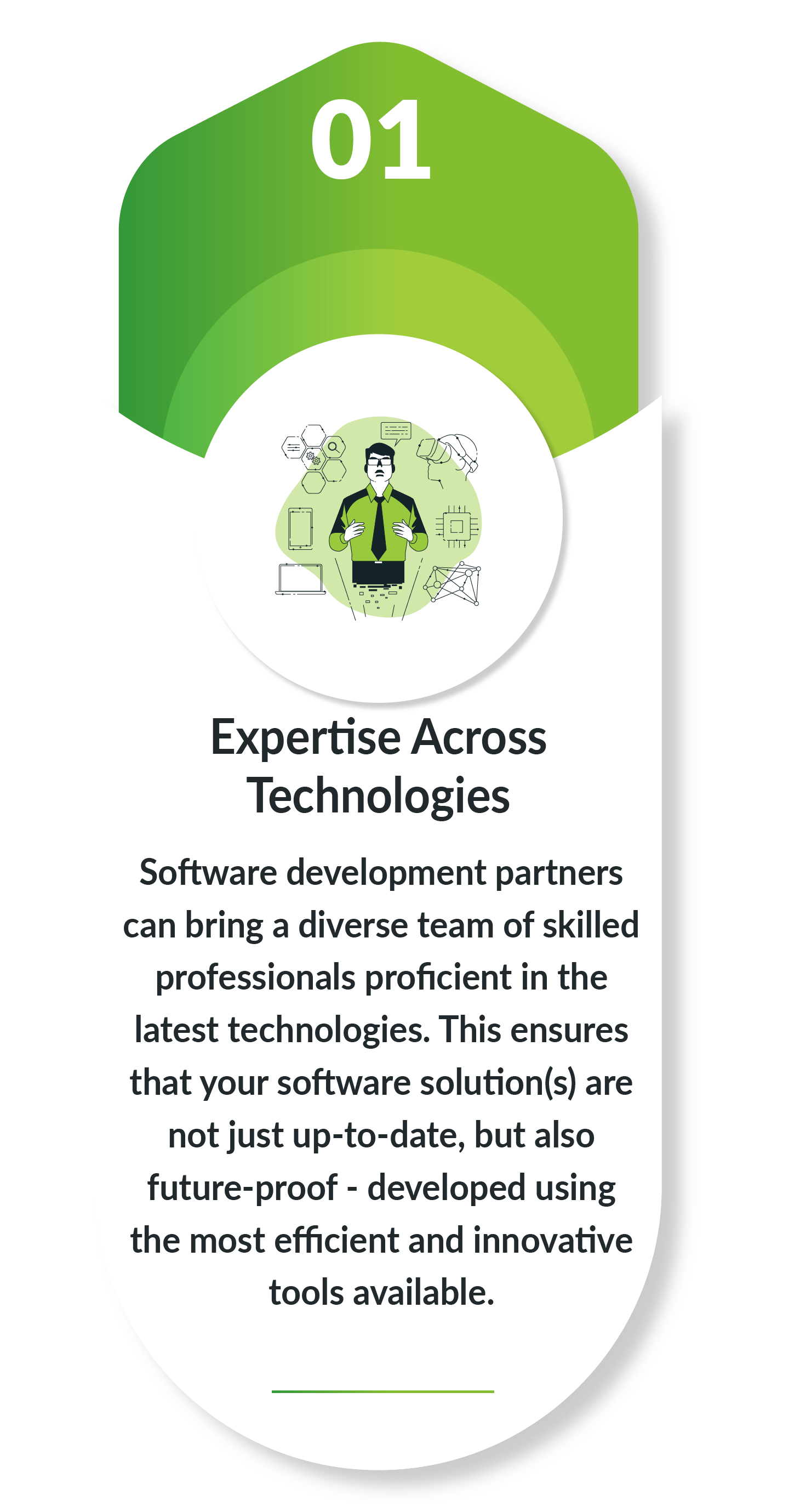
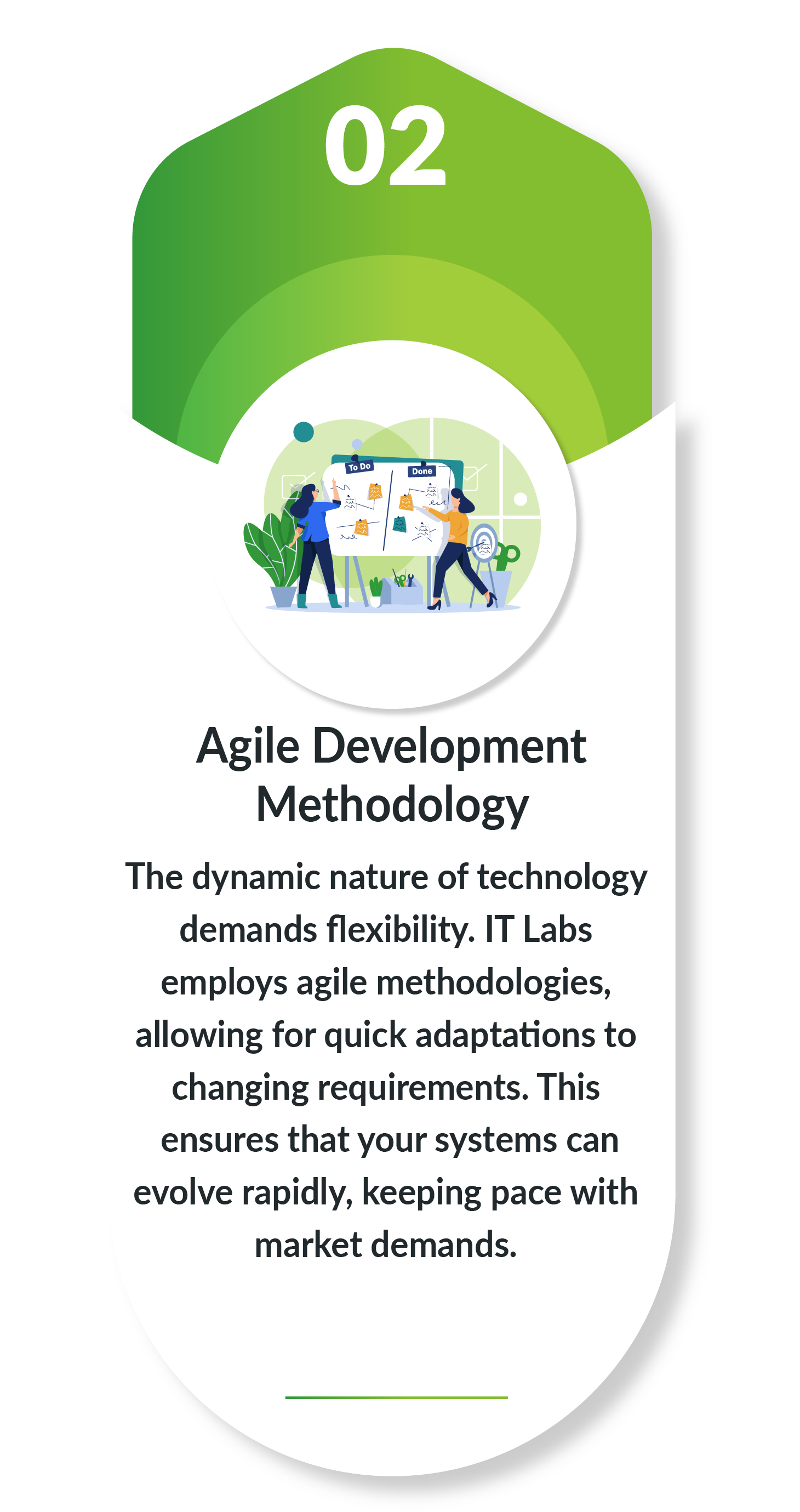
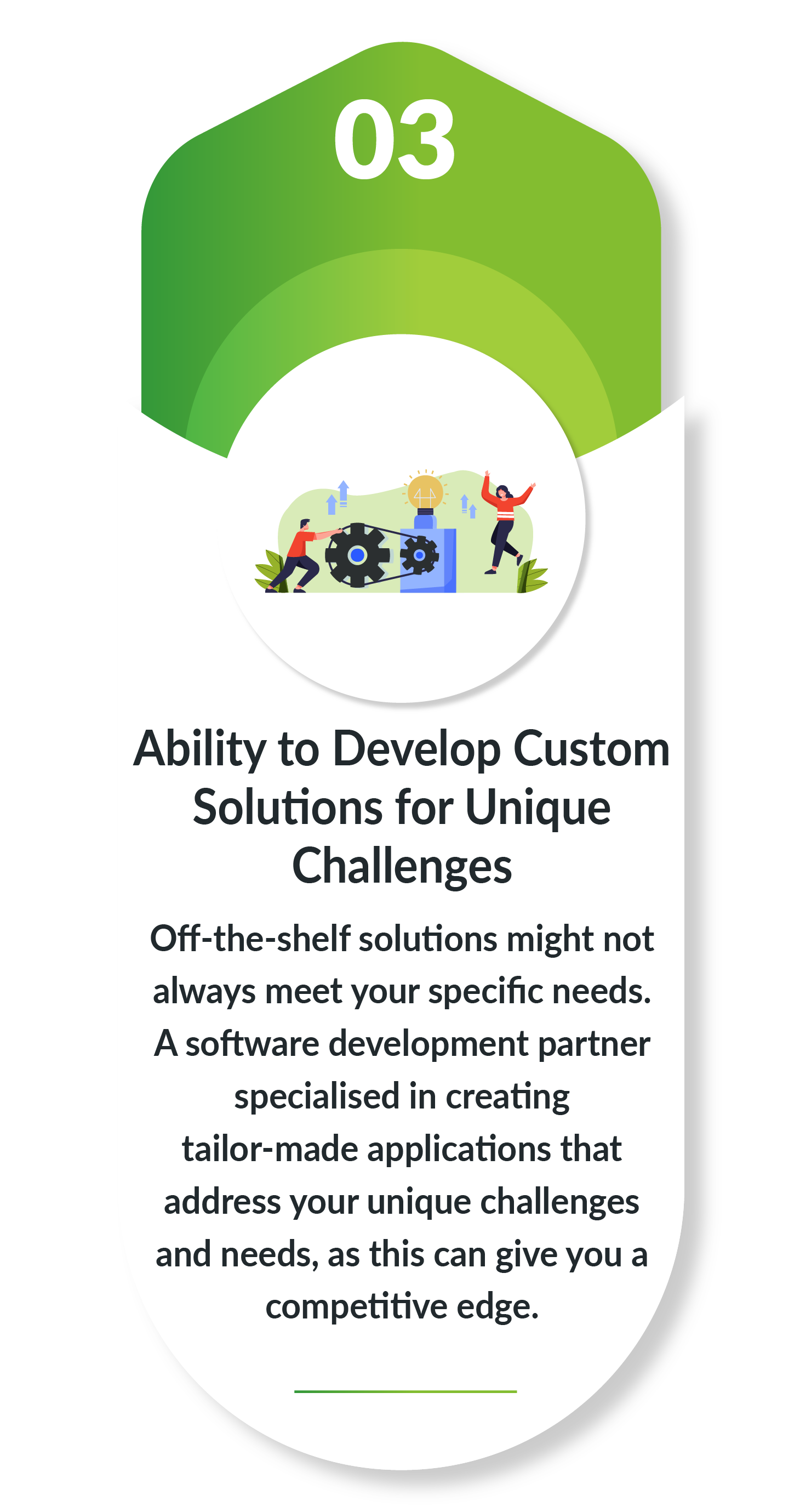
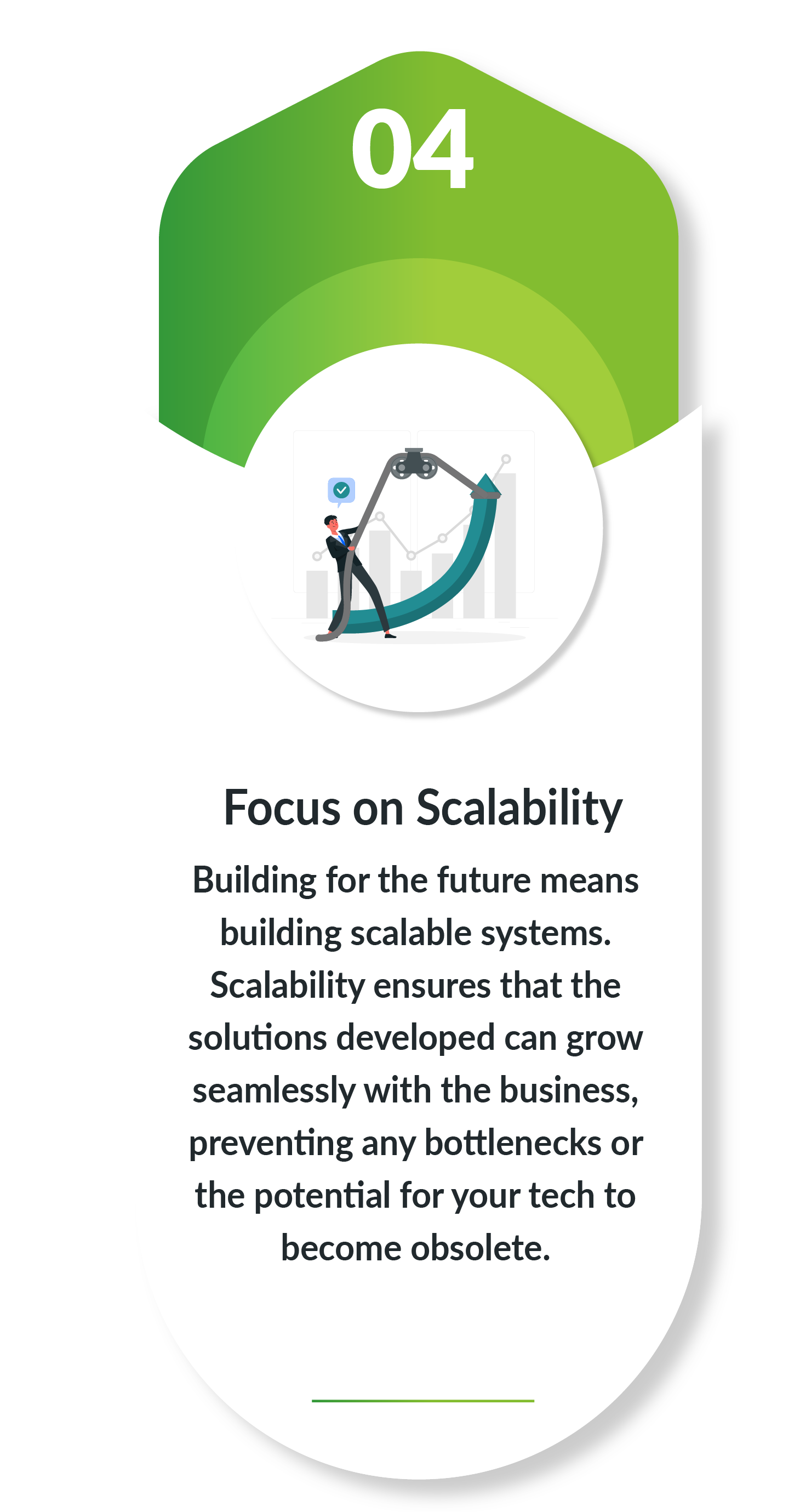
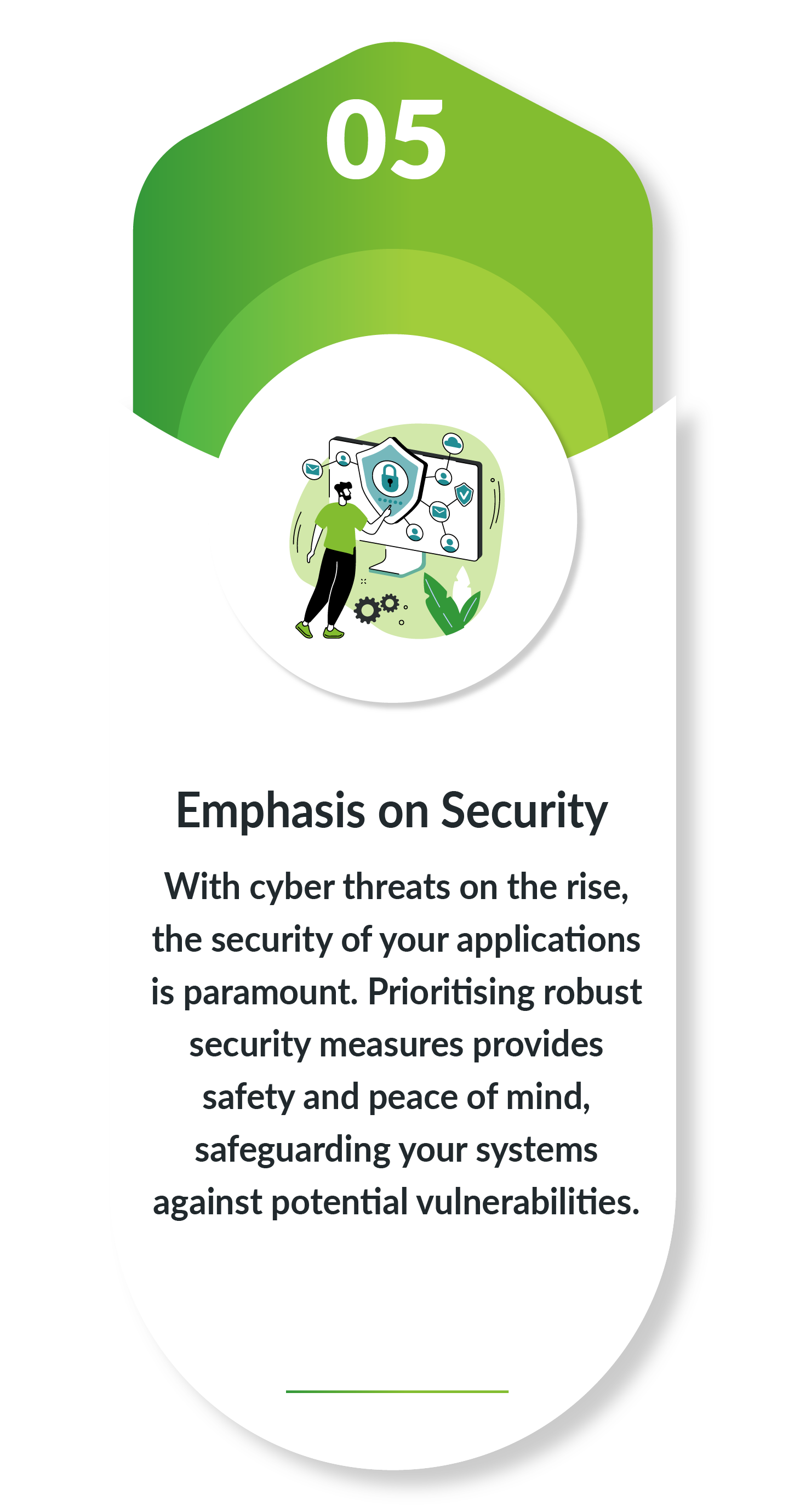
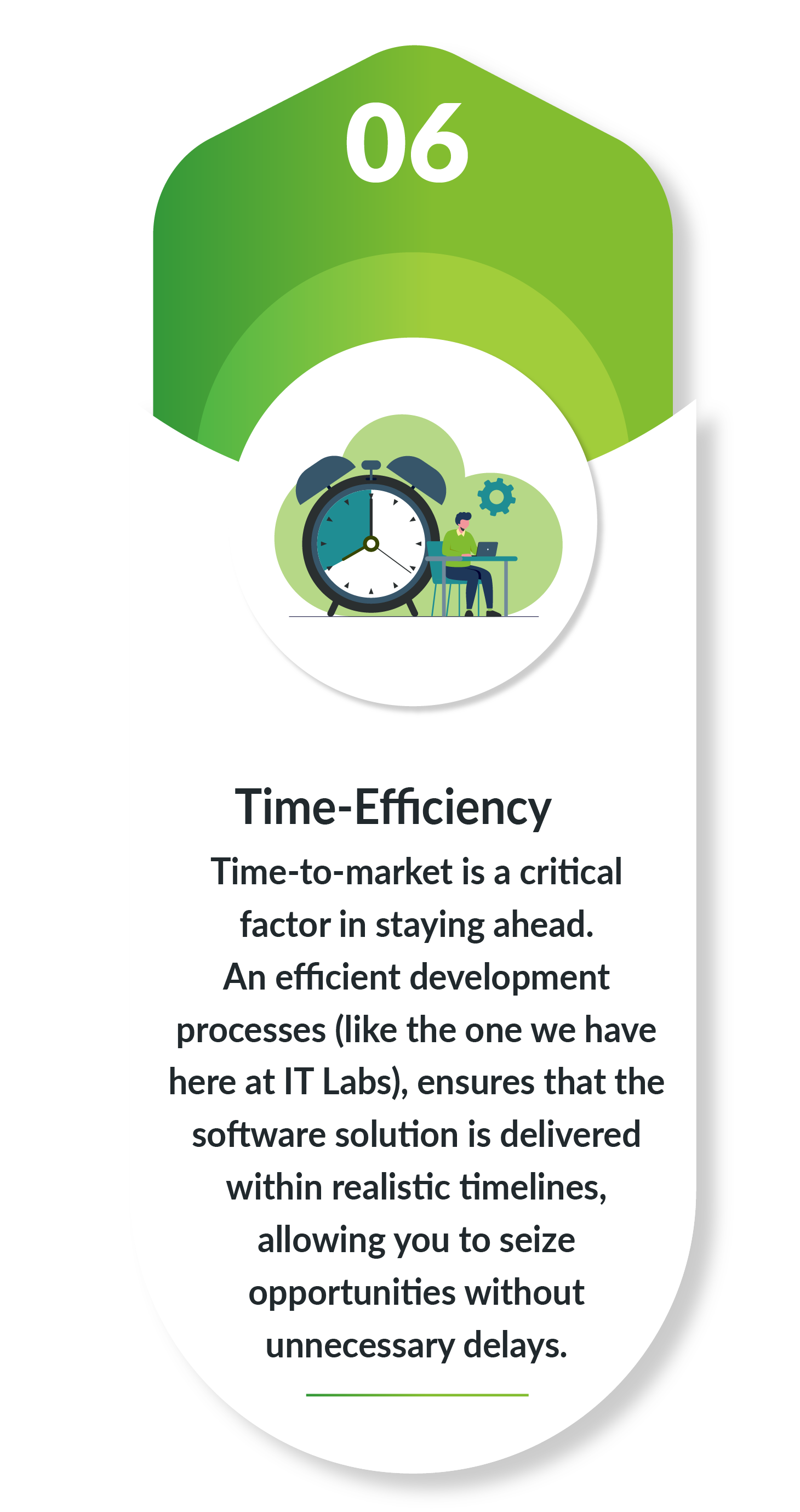
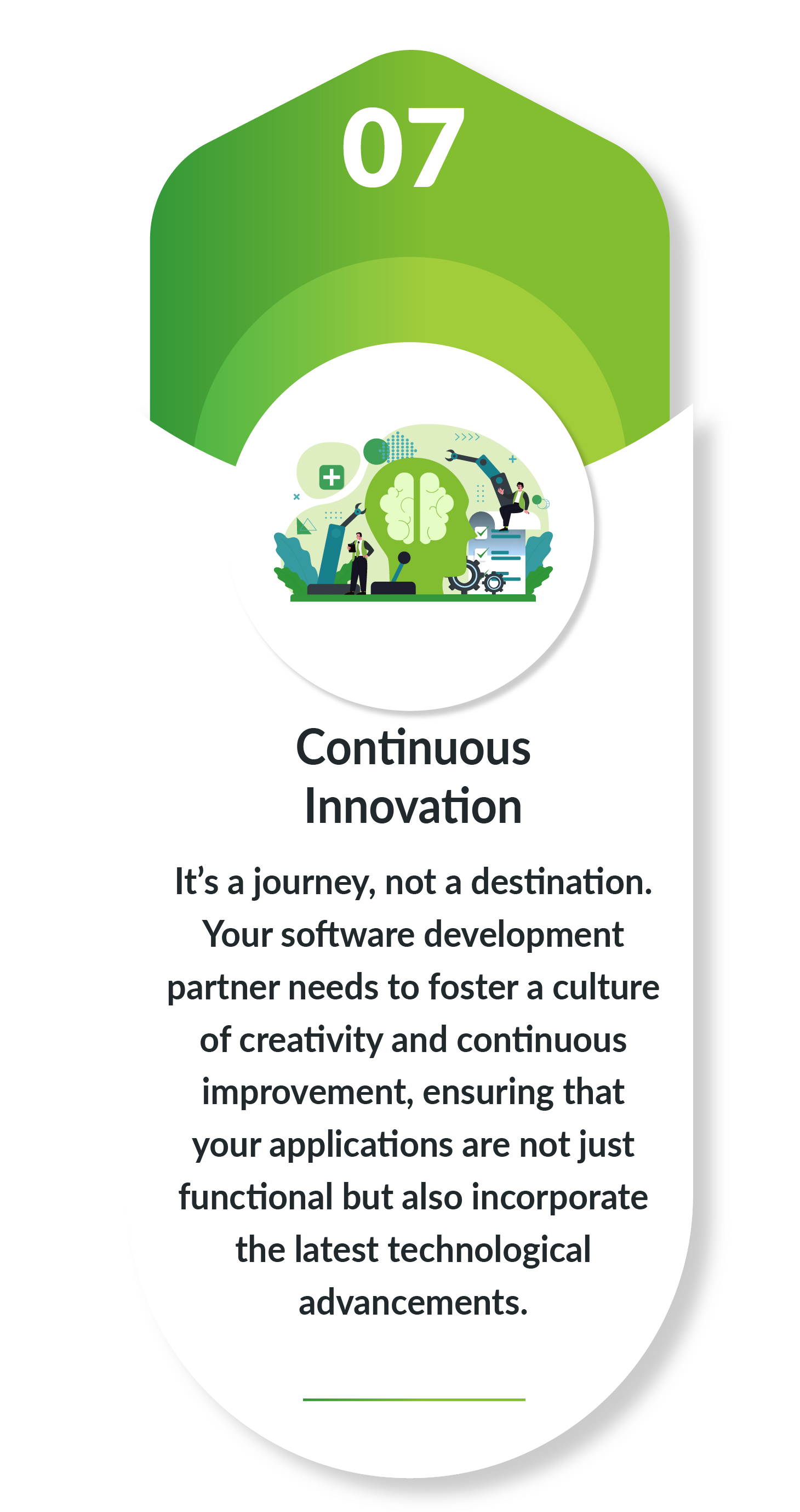
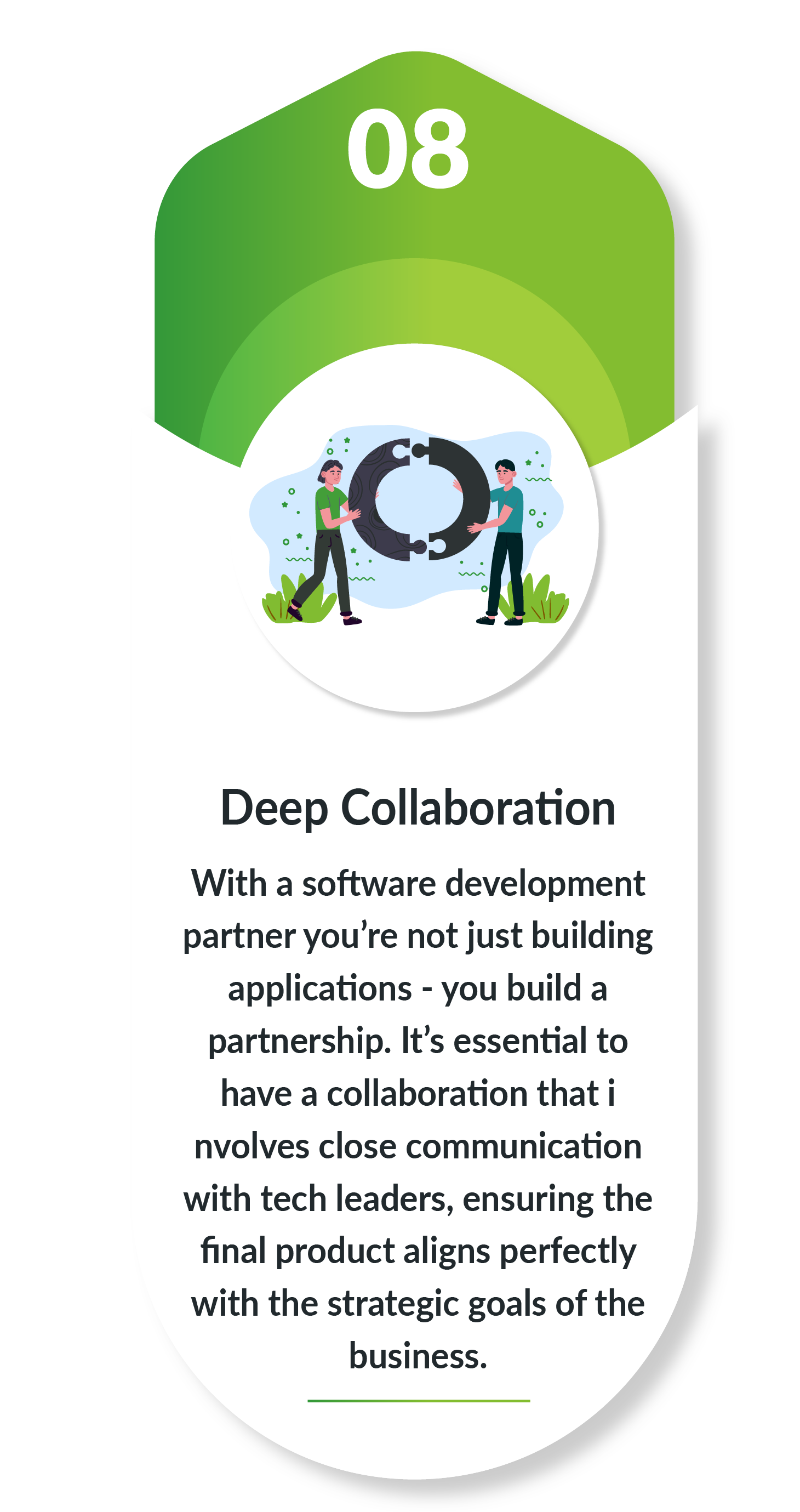
And, of course, there’s always the option of mixing teams – in an era where technological prowess defines competitiveness, the synergy between in-house teams and external expertise becomes a cornerstone for success.
Getting the Collaboration Moving – Process Outline
The process of getting the collaboration moving, it’s important to follow the phases through, as the initial phases are crucial in setting up the collaboration for success.
Our approach for tech leaders wanting to work together in navigate the software development process is listed below:
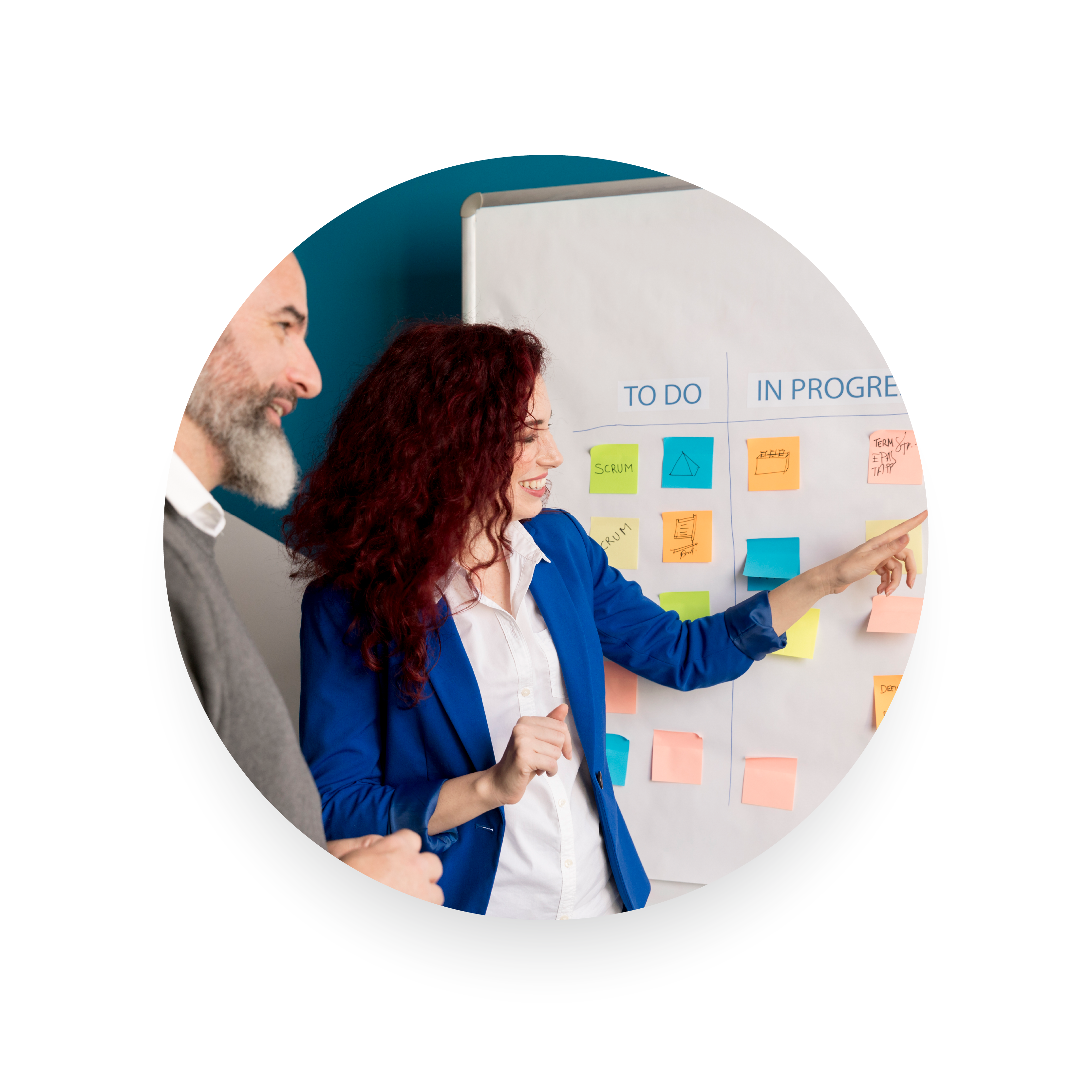
Step 1 – Define Clear Objectives and Requirements
Before embarking on the software development journey, technology leaders must clearly define project objectives and requirements. This includes understanding business goals, user needs, and desired functionalities. Meticulously documenting forms the foundation of the project.
Step 2 – Assess In-House Capabilities
Tech leaders should evaluate their in-house capabilities and expertise. By acknowledging strengths and identifying potential skill gaps, technology leaders can strategically decide which aspects of the project are best suited for internal development and where external expertise would be invaluable.


Step 3 – Forge a Strategic Partnership
Selecting the right software development partner is paramount and tech leaders should opt for a partner, with a track record of success deliveries, diverse tech capacity and innovation. This partnership should not be transactional but collaborative, where open communication and shared goals foster an environment of trust and creativity.
Step 4 – Collaborative Planning and Agile Methodologies
Work closely with the chosen software development partner in collaborative planning. Adopt agile methodologies that allow for iterative development, ensuring that the project stays on track, and adjustments can be made swiftly. This fosters a culture of adaptability and responsiveness to changing requirements.


Step 5 – Radical Transparency in Project Management
Maintain radical transparency throughout the project. Regular updates, transparent communication channels, and shared project management tools contribute to a seamless flow of information between the in-house team and the software development partner. This not only builds trust but also ensures that everyone is on the same page.
Step 6 – Continuous Learning and Innovation
Encourage a culture of continuous learning and innovation. Leverage the expertise of the software development partner to introduce cutting-edge technologies and methodologies. This not only enhances the quality of the final product but also empowers the in-house team with valuable insights and skills.


Step 7 – Budget Management and Deadline Adherence
Collaborate with the software development partner to establish a realistic budget and timelines. Transparent financial discussions and a clear understanding of project scope are essential. Regularly review progress against milestones to ensure that deadlines are met without compromising on quality.
Takeaways
So, in the ever-evolving realm of technology, a partnership with IT Labs emerges as the linchpin for some technology leaders aiming to stay ahead of the competition. IT Labs unwavering commitment to expertise across diverse technologies, agile development methodologies, and a relentless focus on customisation and scalability positions software development providers like IT Labs as not just a service provider, but a strategic ally.
By emphasising security, ensuring time-efficient development, fostering a culture of continuous innovation, and nurturing collaborative partnerships, IT Labs not only builds applications but also constructs a pathway to sustained success.
In choosing IT Labs, technology leaders not only invest in cutting-edge solutions but also embrace a dynamic and future-ready approach that propels their businesses ahead of the curve.

Author
John Abadom – General Manager at IT Labs LTD
Meltano DataOps Tool for ELT Pipelines


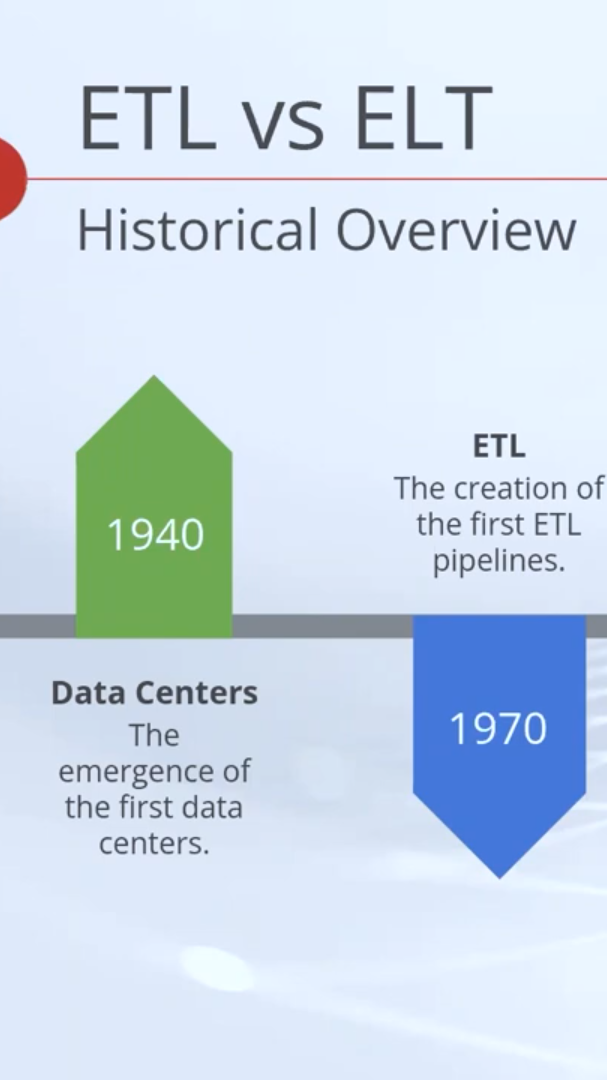
Data is everywhere, but how do we manage it? Working with data and managing it can be a challenging task, and selecting the right data process can be complicated. That’s where Meltano comes in- a powerful open-source ELT framework that can simplify the data-building process.
This open-source ELT framework simplifies the process of building data integration and analytics pipelines. It offers flexibility, extensibility, and a range of features to efficiently extract, load, and transform data from various sources into a target data warehouse. Because of its flexibility, Meltano enables customization and extension of the framework’s capabilities to suit one’s unique needs. In today’s world, overwhelmed with information, data is king- and it’s essential to select the right tools to manage it effectively.
Curious about how to manage data with Meltano? Our latest Re: Imagine Session was held on 31.05.2023 and covered the topic of data and data processing, at which Oliver Tanevski, a Data Engineer from Data Masters, dived deep into the subject of data with focus on Meltano.
Leave behind the overwhelming world of data management and transform your data processing!
Topics covered:
- World of data
- ETL vs. ELT
- Meltano- a framework for simplifying the data-building process
Get ready to elevate your cloud management game!
ReImagine Session - Martin Dimovski Topic Azure Arc, The Future Cloud



Did you know that the future of cloud management is here? Do you know the benefits of using Azure Arc and how it can manage your environment seamlessly?
In today’s rapidly evolving, ever-changing world, businesses are struggling with the challenge of managing complex environments that span across data centers. Azure Arc serves as a bridge that expands Microsoft’s Azure platform’s capabilities, empowering you to build applications and services that can operate across multiple clouds, at the edge and data centers.
With Azure Arc, you can effortlessly organize, control, and secure Windows and Linux servers, SQL Server, and Kubernetes clusters. Curious about how you can leverage Azure Arc to drive your business into the future? Our latest Re: Imagine Session that was held on 23.03.2023 covered this topic, at which Martin Dimovski (DevOps Engineer with 15+ years of experience) answered these questions and many more about the entire scenario of managing on-premises environments using Azure Arc.
Topics covered:
- Azure Arc Overview
- Managing your environment together
- Azure Resource Manager
Get ready to elevate your cloud management game!
Scaling Engineering Organizations for Success with Gjorgji Gjeorgjievski

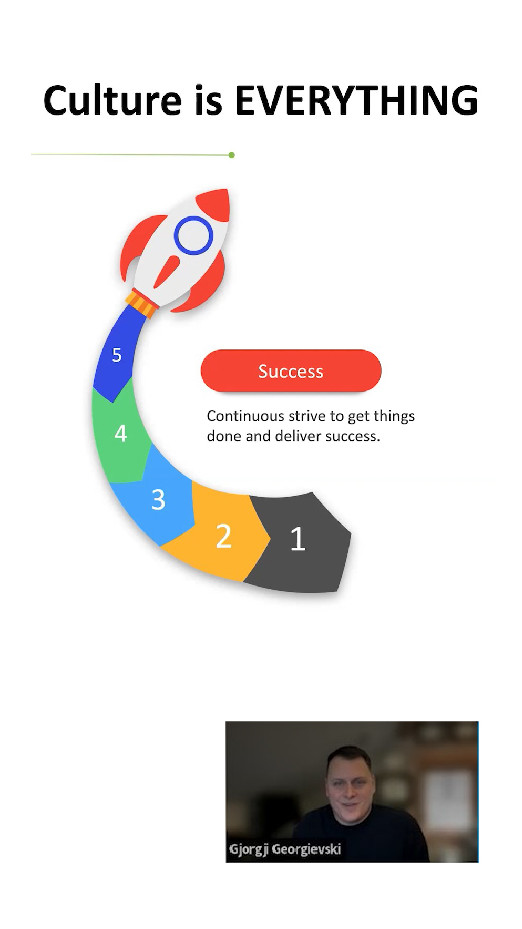
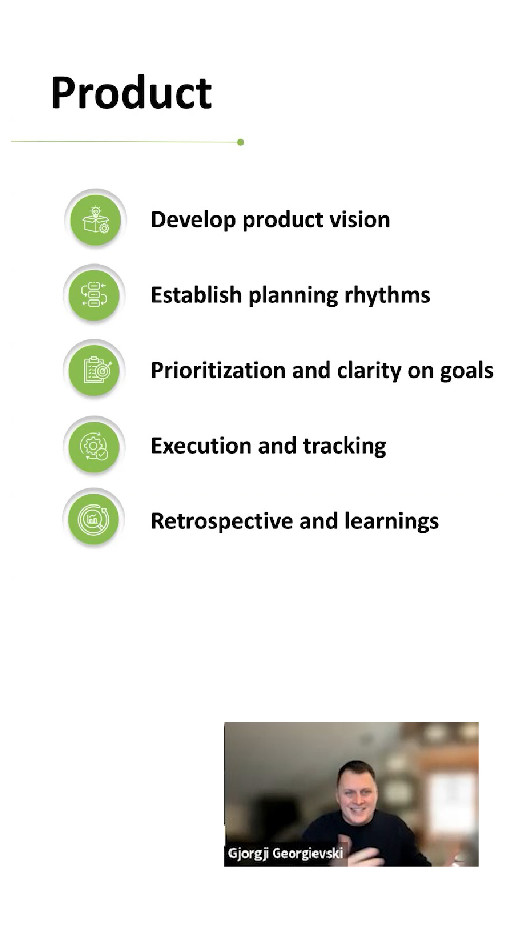
We all know that tech makes the world go round, and that good ideas and tech are financed like there’s no tomorrow – but what happens after? How do they keep growing? In this Re:Imagine session, we had Gjorgji Gjeorgjievski – Director of Engineering of Snowflake – the company that in 2020 had the biggest software IPO ever! The massive growth was fueled by the enormous in novation done by Snowflake’s ever-expanding engineering team. It grew by 50-60% per year, an unprecedented growth for a software company of that magnitude.
On the Re:Imagine Session held on Gjorgji talked about the journey of scaling a small engineering team into a large organization, and all the challenges and fun parts that come with it – including his advice worth it’s weight in gold for all aspiring tech leaders!
Watch the video below for the full session!
Social Housing Technology Benefits
Social Housing Technology Benefits

John Abadom
General Manager at IT Labs LTD
Housing Associations and Technology: Why the Two are a Good Pair
Housing associations and local authorities have a crucial role in ensuring that people have access to affordable and secure housing. They must balance the need to provide quality housing with the need to operate efficiently and effectively. Technology can be a powerful tool for improving business processes, reducing costs, and enhancing the services that housing associations provide to their tenants. In this article, we will explore how social housing technology can improve business processes.
Digital Communication and Collaboration
One of the most significant ways technology can improve business processes is by enabling better communication and collaboration. Housing associations can use technology to create a digital platform where tenants can report issues, request repairs, and communicate with the association. This is especially important as the Regulator of Social Housing (RSH) stated in September 2022 that registered social housing providers must collect and share information on repairs, safety checks, and complaints with residents. By having a digital platform, associations can streamline communication, reduce response times, and track progress. It will reduce the need for face-to-face interactions, saving time and resources, an. An example is Plus Dane Housing launching its new customer portal.


Cloud-based Systems
Cloud-based systems can be used to manage housing association data, allowing for efficient data sharing and storage. A good example was Clarion Housing Group’s digital transformation accelerated by Hitachi Solutions a few years ago. By using cloud-based systems, housing associations can access information from anywhere at any time, making it easier to manage and share information across different departments. This can help improve decision-making, reduce response times, and improve overall efficiency.
Automated Systems
Automated systems can be used to streamline repetitive tasks and reduce human error. For example, housing associations can use automated systems to manage rent collection and track maintenance schedules and repair requests. This can reduce the time and resources required for administrative tasks, freeing up staff to focus on more complex tasks. Poplar HARCA is an excellent example of a housing association that successfully automated its accounts payable process.


Data Analytics
Data analytics can be used to provide housing associations with valuable insights into tenant needs and preferences. By analysing data on tenant preferences, housing associations can make informed decisions about the services they offer and the types of housing they provide. This can help improve tenant satisfaction and reduce tenant turnover. Back in 2014, Gary Hind, Head of IT at Bernicia Group, led his housing association into introducing a new housing management business intelligence solution that enabled them to monitor performance and risk better plus respond to other matters more speedily.
Mobile Apps
Mobile apps can be used to improve communication and provide tenants with access to services. Housing associations can develop mobile apps that allow tenants to request repairs, report issues, and access information about their tenancy. This can help improve tenant satisfaction and reduce response times. Stirling Council rolled out and installed 50,000 sensors into 6,000 properties. Data from the sensors is fed into a mobile app called HomeLINK which immediately alerts residents of any issues in their property i.e., if the temperature is too hot, cold, or humid.


Internet of Things (IoT)
The Internet of Things (IoT) can be used to provide housing associations with real-time data on tenant needs and preferences. IoT devices, such as sensors and smart meters, can monitor energy usage, water consumption, and other aspects of daily life in housing units. This can help housing associations identify and address issues proactively, reducing the need for reactive maintenance. Back in November 2022 Onward Homes, Places for People, Raving Housing Trust, RHP Group, and Thorngate Churcher Trust were all finalists at the Inside Housing Innovation Week Award which recognises a social housing organisation that uses technology and the Internet of Things to improve lives, solve problems and deliver real genuine benefits to communities.
Virtual Reality
Virtual reality can be used to provide tenants with virtual tours of housing units, allowing them to explore properties before deciding to rent or buy. This can help housing associations save time and resources by reducing the need for in-person viewings. Virtual reality can also be used to train staff, allowing them to practice different scenarios in a safe and controlled environment. Kingdom Housing was one of the first housing associations to use virtual reality (you can read more here) which features Gary Haldane, Interim Digital Director at Kingdom Housing Association.


Blockchain
Blockchain technology can be used to provide secure and transparent record-keeping for housing associations. By using blockchain, housing associations can ensure that all transactions are recorded and can be audited. This can help improve transparency and reduce the risk of fraud. Together Housing Association partnered with UrbanChain to reduce households’ carbon footprints and energy bills. The pioneering scheme enabled UrbanChain to onboard 500 Together Housing Association homes into its P2P exchange, enabling buyers and sellers of green energy to transact in a secure and safe environment with complete transparency.
Artificial Intelligence (AI)
Artificial Intelligence (AI) can be used to automate tasks and provide housing associations with valuable insights. For example, AI can analyse tenant data, identify patterns, and provide recommendations for improving services. AI can also be used to develop chatbots that can assist tenants with routine tasks, such as reporting issues or requesting information. Peabody, London Borough of Camden, Community Housing, and Cobalt use machine learning to help maximize rent collection, identify tenants needing support, and transform productivity. This enables social landlords to manage rent arrears more efficiently.

To Sum Up
It is essential to recognize that technology in the social housing space enables better digital communication and collaboration and creates environments for better data sharing and process automation, especially for residents and staff. Mobile Apps and IoT provide greater visibility to residents, and social housing landlords, in having real-time asset data access to better manage property dampness and mould, disrepair, energy bills, well-being, and much more. Virtual reality, Metaverse, mixed reality, and virtual world technologies offer a greater variation on how social housing landlords can expand their use of internet technology to provide residents and staff with environments where they can interact with computer-generated content and other users. Microsoft’s vision of the Metaverse can be explored in the following video:
AI enables social housing landlords to get closer to tenants by offering services and understanding behaviours, demographics, and needs. Also, using automation can be beneficial for analysing customer feedback, as Flagship Housing introduced this approach across its operation. But all this hinges on having accurate data as a foundation for AI or predictive analytics projects.
Blockchain can drive affordable housing by enabling social housing interactions and transactions through trusted intermediaries to be automated through technology. Blockchain can enable easier property search, improve pre-purchase due diligence, reduce the needs for intermediaries, provide smart property contracts, offer safe property transactions, reduce entrance into home ownership and turn social housing stock into a liquid asset.
Technology can provide housing associations with tools to improve business processes, reduce costs, and enhance services. By embracing technology, housing associations can become more efficient, effective, and responsive to tenant needs.

Author
John Abadom – General Manager at IT Labs LTD
Re:Imagine Session - ‘How do Recruiters find the Best Candidate for the Job?
How do Recruiters find the Best Candidate for the Job?

Elena Dvorchanec
Talent Acquisition Specialist
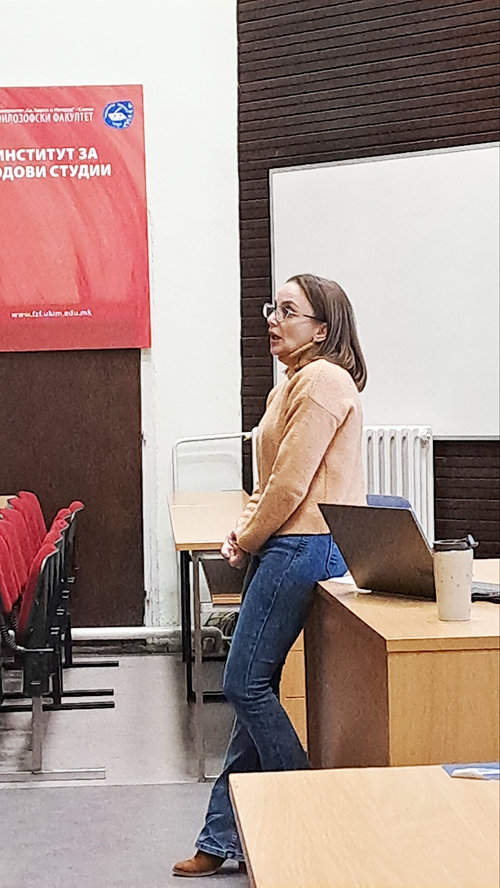
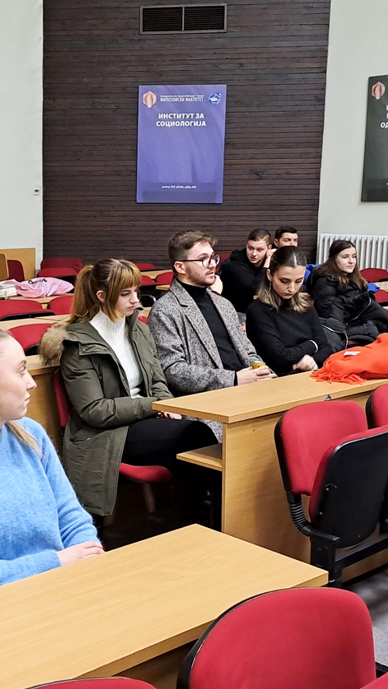
Many of us have been through interviews and have seen the entire process by being part of it, but is the recruitment process the same on both sides of the fence? Is it the same for interviewee and the interviewer? How does the process look like for the recruiters? I answered all these questions and many more, as part of the Re:Imagine Session I held at the Faculty of Philosophy – Skopje.
The point of the session was for aspiring recruiters and people who will jump into the labor market to better understand what’s happening on both sides of the fence, as a way for both applicants and recruiters to find the job/candidate they want.
The Five Phases of The Selection Process
The whole recruitment process, or better said, the work of a recruiter includes networking, screening, interviews, presenting the company, preparing, connecting applicants and candidates with managers and technical personnel – just a myriad of tasks and responsibilities, all important for the recruitment process, and crucial for finding the right candidate for a position.
But better yet – we can divide this process in five phases:
- Preparing
- Sourcing
- Interview
- Selection
- Hired
Each of the five phases is self-explanatory, and the hiring process seems like a straightforward job – you match people with criteria, education, and skills and find the right one – right?!
Well, the reality is much more complicated than that – as a variety of factors can influence the process and set us back a few steps, which can take a bit more time than initially expected.
Let’s dive in the five phases, and the potential issues that can come up.
Preparing
The first phase of the recruitment process is the most important, as it sets the pace for all the following phases. When a request to fill up a position comes in, the first step is to create a job ad, which will include all the information about the position: requirements, qualifications, benefits, description of responsibilities – basically all the information a job seeker would need in order to decide if they’re a fit for it.
After creating the job ad, a strategy is developed to decide which channels and methods would be best to run the job ad. Social media? A newspaper ad? Maybe TV?
In this phase, the two steps described above can go smoothly only if the recruiter clearly understands what the “ideal candidate” looks like. This means they must acquaint themselves with the position, the requirements, the terminology, the industry – these are all time-consuming but crucial if we want to find the best candidate.
I’ve got just the example of how this can sometimes be difficult:
A while ago, while working for another company I got a request from management to look for a someone to lead the financial department. First, up until that point, I was a recruiter whose experience was all around people who work in tech – developers, QAs, BAs, project managers – and industrial workers. I had zero experience recruiting someone from finance, let alone understand the skills and qualifications a person should have to lead a financial department.
So, me and other colleagues from my team started from scratch – I contacted some of the people in the financial department, talked with them in length to get a better picture and better visualize the person that would need to carry out the responsibilities would come with the position. After knowing all about the position, we set about publishing the job ad – and the first thing we did was decide that we won’t use traditional ways and just publish that we have an open position and wait for applicants. Instead, we used LinkedIn and searched for the candidate – meaning we shortened our search by ensuring that we would target the people with the niche qualities and skills we were looking for – and avoid a pile of potentially underqualified applicants.
Understanding the position, the responsibilities that come with it, will help you immensely in figuring out what characteristics the perfect candidate for the position will have, and how to find them. It’s not the same to look for C-level executives and juniors – they spend their time on different social media platforms, their online habits differ, and different types of benefits and opportunities appeal to them.
Sourcing
Once we know the profile and the characteristics, we want our ideal candidate to have, we set about with sourcing. We’re looking through existing profiles and candidates, but also new ones, and we set about seeing how they applied – are they referrals? LinkedIn? Are they a candidate that has already applied previously for a similar position? These are all important because of the following:
- Referrals – candidates that have joined companies through a friend or an acquaintance tend to stay longer at companies than candidates who have joined companies through direct contact from recruiters or have applied by themselves – making this one of the best ways to recruit. Of course, it’s important to reward the employee while doing this, and ensure that their efforts are appreciated.
- LinkedIn and/or other online platforms – the platforms and the profiles of the people who apply are important, as you can see their network and see who they associate with, gauge their interest and engagement with important players from the industry – these metrics can help you in understanding the candidate before an interview.
- Job Fairs – not only do you get the chance to present your company, but you can also see how your employer branding strategy is performing based on the kind of people interested in your company and see if your efforts are in the right place. Furthermore, you can consider this an interview before the interview – you can talk to those who show interest and see what they’re looking for and spread your network!
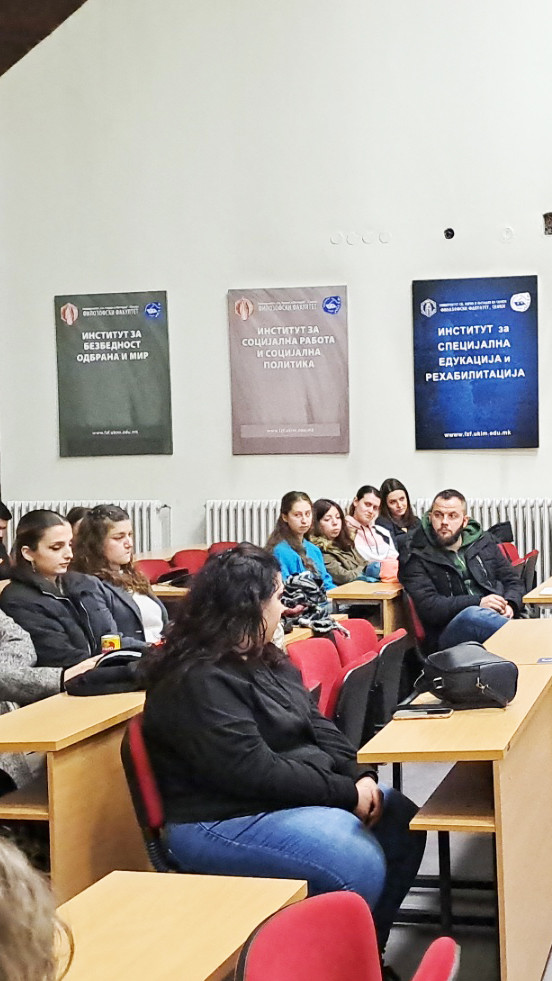
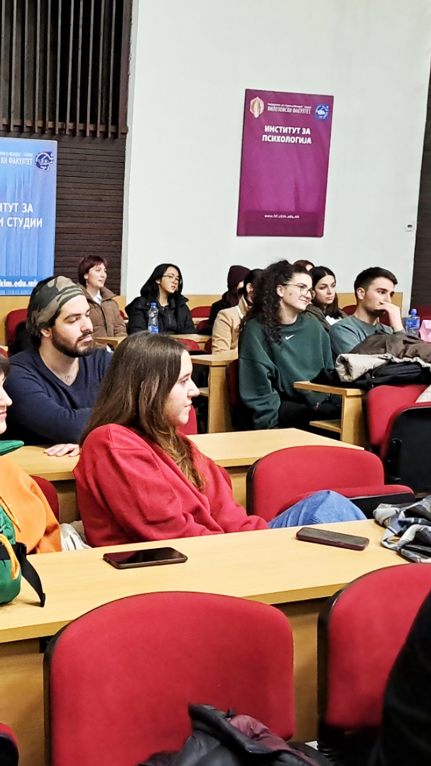
The Interview
Okay, so once we have our “ideal candidate” profile, and we’ve gathered a sizeable number of applications (or not), it’s time to get down to the interview!
Many things have changed about recruitment in recent years – for recruiters and for candidates, but the one thing that hasn’t changed is the interview. Of course, it has changed in some ways – the questions, the discussion, the relations – but it hasn’t changed in meaning. People still think of interviews as a make or break because an interview paints a picture of the candidate’s personality, but it’s also a method for recruiters to explain the position, the company, and to establish a relationship.
The interview can vary in the way it’s conducted – the number of people interviewing a candidate (one, two, even more!), the way to which channels are used (over the phone, online, in person), whether it’s structured or not – and sometimes it takes a few rounds of interviews. And while all of these play a key role in what recruiters learn about the candidate – it’s also the other way around. That’s why the interview process should have a sort of a structure, which will help both sides get better acquainted.
It should be something like this:
- The interviewer(s)/recruiter(s) introduce(s) themselves
- The candidate introduces themselves
- Question phase (behavioral, situational, technical)
- Presenting the company, the project, the position, the benefits
- Questions from the candidate
- Disclosing what the next steps of the process are
Remember, the interview is a chance for candidates to present themselves in the best way, but also a chance for you as a recruiter to present the company properly!
Selection Phase
The selection process begins once we as recruiters (also all involved in the recruitment process) have gathered enough information about the candidates, and we start to see which one is best aligned with what we’ve envisioned as the “perfect candidate” from all standpoints – skill-wise, experience, cultural fitting – all the aspects that we consider as important.
After we find the one, we start the negotiations process by offering them the role and discussing all aspects of his employment.
Hired and Onboarding!
Once the candidate has decided to join your job as a recruiter has been finished, right?
Well, yes and no – paying attention to how your recruits are doing, seeing how they fit in, and watching them grow and develop is one of the most rewarding and educational experiences one can have. So, I strongly recommend you all to do it – a check-up here and there, catching up, seeing how they do – and enjoy that you’ve helped someone!
Finishing Thoughts
Sure, the recruitment and job-seeking process is a lot more complex than what I’ve laid out here, but these are the essentials, and all the other elements depend on all the factors we can rarely control. Sometimes candidates will pick a position somewhere else, some even may turn you down, or you might even spend months before finding the right candidate. Still, in the end, it’s all about matchmaking – matching a person with their dream job, and a company with an employee that can grow, develop, and contribute to the company!
Stay tuned for the upcoming Re:imagine session on www.it-labs.com/events.
Fiber Optic Communication:
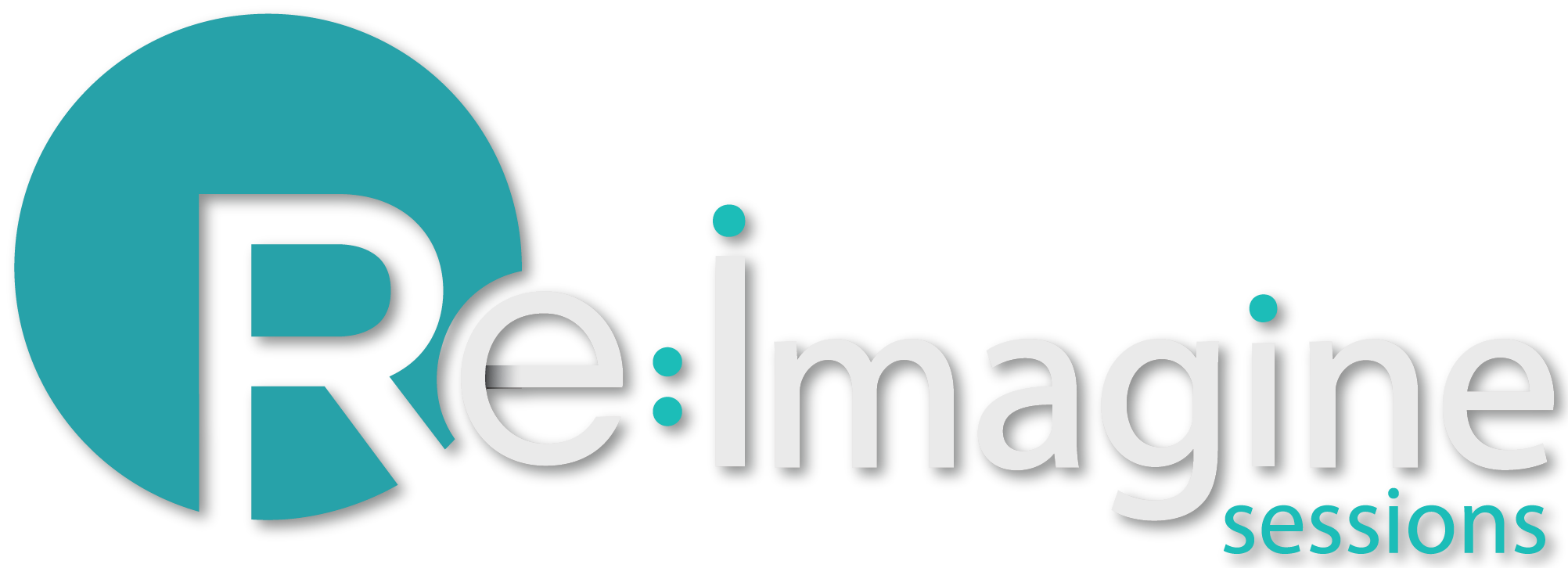
Fiber optic Communication:
Applied Science and Implementation Scenarios with Blagoj Trajkoski

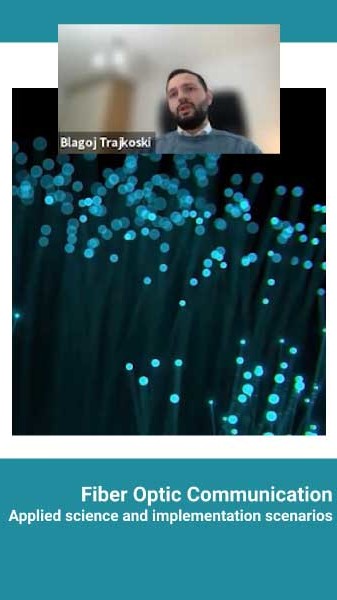
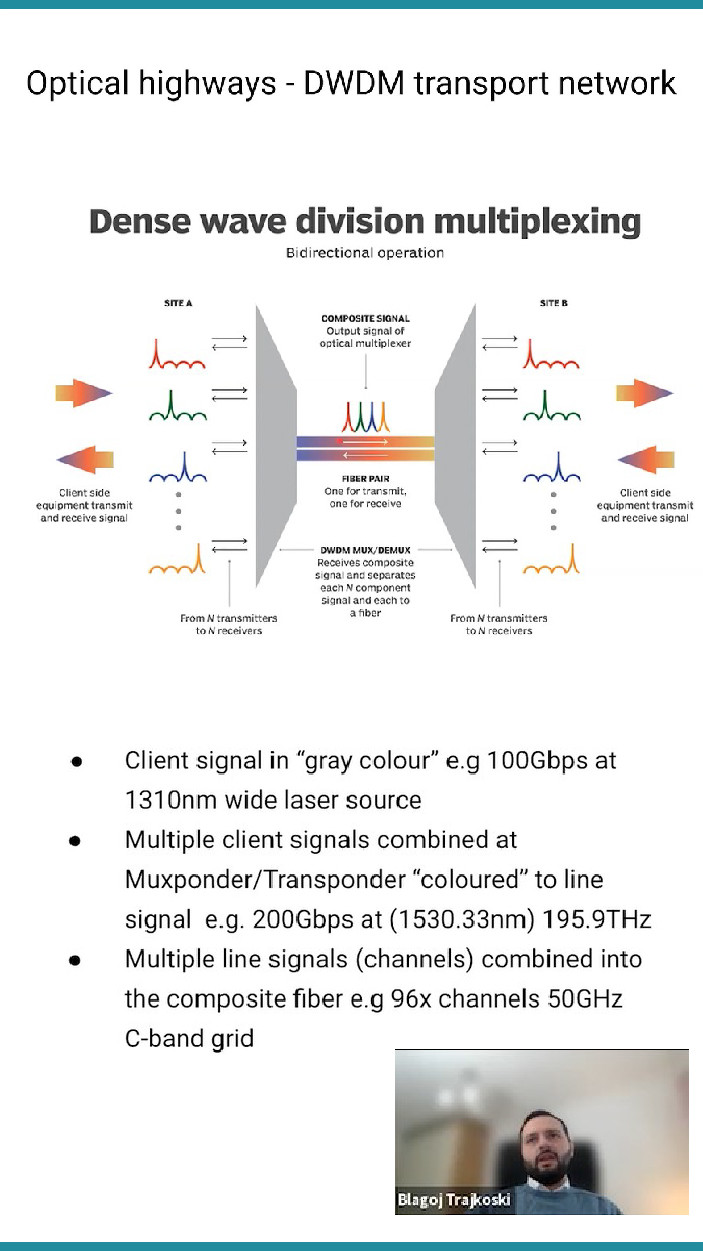
In the era when the volume and the speed of information transfer is increasingly valuable it’s very important to understand the technology behind it. It’s the speed of light that enables us to communicate in real time while we are on different continents around the globe. And thanks to that and the silica we were able to use fiber optic systems as irreplaceable digital communication systems.
In this Re:Imagine session held on 23.01.2023, we had Blagoj Trajkoski, Optical Network Engineer at Google, who explained the role of the fiber optic networks, while introducing the concepts of the physics applied behind it. By clicking PLAY on the video below, you will hear from Blagoj as he will walk through one “optical highway” with the accent of the amplification blocks. In the end, you’ll have the chance to look at and hear about some of the latest achievements in this field and the limitation factors.
Click play for the full session!


